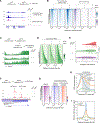SPT5 stabilization of promoter-proximal RNA polymerase II
- PMID: 34480849
- PMCID: PMC8687145
- DOI: 10.1016/j.molcel.2021.08.006
SPT5 stabilization of promoter-proximal RNA polymerase II
Abstract
Based on in vitro studies, it has been demonstrated that the DSIF complex, composed of SPT4 and SPT5, regulates the elongation stage of transcription catalyzed by RNA polymerase II (RNA Pol II). The precise cellular function of SPT5 is not clear, because conventional gene depletion strategies for SPT5 result in loss of cellular viability. Using an acute inducible protein depletion strategy to circumvent this issue, we report that SPT5 loss triggers the ubiquitination and proteasomal degradation of the core RNA Pol II subunit RPB1, a process that we show to be evolutionarily conserved from yeast to human cells. RPB1 degradation requires the E3 ligase Cullin 3, the unfoldase VCP/p97, and a novel form of CDK9 kinase complex. Our study demonstrates that SPT5 stabilizes RNA Pol II specifically at promoter-proximal regions, permitting RNA Pol II release from promoters into gene bodies and providing mechanistic insight into the cellular function of SPT5 in safeguarding accurate gene expression.
Keywords: CDK9; Cullin 3; NELF; RNA polymerase II; SPT5; VCP; auxin-inducible degron; degradation; elongation; transcription.
Copyright © 2021 Elsevier Inc. All rights reserved.
Conflict of interest statement
Declaration of interests The authors declare no competing interests.
Figures







References
-
- Anindya R, Aygün O, and Svejstrup JQ (2007). Damage-induced ubiquitylation of human RNA polymerase II by the ubiquitin ligase Nedd4, but not Cockayne syndrome proteins or BRCA1. Molecular Cell 28, 386–397. - PubMed
Publication types
MeSH terms
Substances
Grants and funding
LinkOut - more resources
Full Text Sources
Molecular Biology Databases
Miscellaneous

